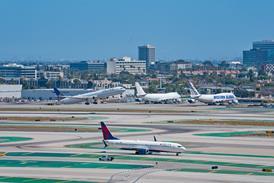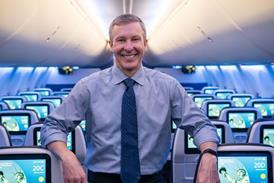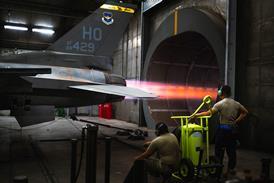The evolution of new equipment demanding new skills of operators and the vastly altered aerial battleground since the last generation of military trainers entered service are two aspects of the changing military universe. Others include the growing cost of training and the culture of efficiency consciousness, the latter leading to debate on the best use of simulators.
But the most worrying of all to decision- makers is the apparent universal difficulty in recruiting and retaining the "best and the brightest" to the armed forces.
"This is a very important time for lots of air forces, and, indeed, I suspect for the military in general, in terms of turnover of training and equipment," says Air Marshal Sir Christopher Coville, air officer commanding-in-chief of the UK Royal Air Force's Personnel and Training Command. Partly due to recent technology advances, he says, "we've now got to the stage where we need to start looking very seriously at upgrading and replacing basic elements of our training systems".
Much industry attention is focused on the UK as the Ministry of Defence prepares to privatise and modernise its fixed-wing flying training under the Military Flying Training System (MFTS) programme. This will be achieved under one or more contracts, each worth billions of pounds sterling (Flight International, 18-25 July 2000). Rather than replace the Shorts Tucano T1 and BAE Systems Hawk T1 stocks, MFTS requires the provision of a service.
A procurement strategy should be determined by mid-2002. Downselection is tentatively set for 2003, and the in-service date for 2004, "depending on the procurement structure we follow", says Grp Capt Peter Coker, UK MFTS integrated project team leader. Instead of working to equipment out-of-service dates, the aim would be to "try to establish good training" early on before making the transition to new aircraft and training methods. Coker stresses, however, that the project is "a rapidly changing scenario, still in the concept phase", and possibly the UK's most complex military procurement programme ever.
Industry has received several updates on the programme's development. Coker says that building relationships with industry is crucial in these early days, with "engagement" set to intensify from around October in forms such as joint studies, depending on ministerial agreement to so proceed. The idea of an "initial gate" approval for MFTS to proceed has become deformalised; instead of a gate next month, as originally planned, "our intention is to try and 'tease out' key points early", Coker says.
Pinpointing issues
Several studies are ongoing under a year-long training needs analysis (TNA), launched last October to pinpoint specific issues that MFTS must address. The widely divergent issues include input standards for the UK services' operational conversion units of the future and skill needs, and many other points. Such factors relate, for instance, to questions in the National Audit Office's Training New Pilots report last year about "output creep", or increasing expectations, facing trainee aircrew.
When standards are "clearly, clearly defined, that then fixes the whole way you train", says Training (Air) Gp Capt David Harrison, of the Training Group Defence Agency. Harrison co-authored Project 08, the study out of which MFTS has emerged. Harrison goes on to say: "The provision of a predictable and robust training pipeline will make a significant contribution to the delivery of future manpower requirements." Average fast-jet training takes 3.2 to 3.5 years. Harrison says: "We hope to improve that under MFTS, but it's impossible at this stage to say by how much."
The questions most often asked about MFTS by industry, Coker says, involve the concept of "military ethos". This issue is under study by the TNA project team and is a factor in the key system requirements: "The requirement to instill and maintain military ethos throughout the training system will underpin the entire future success of the aviation arms of all three services and must be a common thread through all stages of training."
The UK is "adamant" that such an ethos must be present in its training. "The key question," Coker says, "is how do we maintain a military ethos, and develop this? It's an undefinable product at the moment."
A commitment to a military ethos is also a deeply held tenet of US Air Force flight training - so much so that the service wants only military pilots instructing newcomers to the ranks. Gen Hal Hornburg, commander of the USAF's Air Education and Training Command, says: "You take good pilots in to be instructors for three years or so and then send them back out. It inculcates our air force military culture and enables students to identify with another military pilot - not just a flight instructor." He adds: "That's not saying the other systems won't work, but this is the way we intend to go."
Hornburg acknowledges, however, that the USAF is "having difficulties finding the numbers [of instructor pilots] it needs". In fact, he points out, "we don't have enough pilots in the [active-duty] air force right now to fly operational missions". The full- time active-duty USAF instructor corps is currently bolstered by pilots from the Air National Guard and USAF Reserve programmes, "which help us out a great deal here. If we were left with only active duty, as we used to have, we would probably be looking at a contractor programme similar to other nations."
As part of its deliberations on military ethos, the UK TNA project team is also considering the best ratio of military to civilian contractor instructor pilots, and trying to define it. A policy of mass export of training to outside the UK is not an idea being encouraged of potential contractors in MFTS concept development. The UK sends some pilots to Australia and Canada for training, but anticipates continuing to conduct the greatest bulk of its flying training on home turf - unlike European neighbours which participate in the Euro-NATO Joint Jet Pilot Training (ENJJPT) programme in the USA.
Lack of capacity
The Royal Netherlands Air Force (RNLAF), for example, sends 10-20 student pilots each year to the USA at a cost of $500,000 each for 260h of flying training under ENJJPT. Part of the deal is sending RNLAF instructor pilots to the USA for a three-year exchange. "The Netherlands does not have the capacity or the capability to deliver a whole flying training programme by itself," says 1st Lt Annemiek Macco, who flies the Lockheed Martin F-16 Mid-Life Upgrade with the RNLAF's 323 Squadron.
The ENJJPT approach is to teach pilots to fly advanced jet trainers and F-16s in the benign conditions offered in relatively uncrowded and clear US skies, alongside other NATO alliance pilots. Macco believes her training, far from the distractions of home, worked to her advantage - particularly flying often and in more predictable weather and airspace. "You have to learn to crawl before you can walk," she says.
An aspect of unpredictability which faces UK planners in developing the MFTS documents and programme, which is set to run for roughly 30 years, is the very future itself. Unmanned air vehicles could reduce the need for pilots, for example. To address the unforeseen, when and if such unknowns occur, "the system needs to be flexible, and we need to build an up-close relationship with the party providing the service", Coker says. "Obviously, we will need some checks and balances in place; it works both ways."
Source: Flight International























